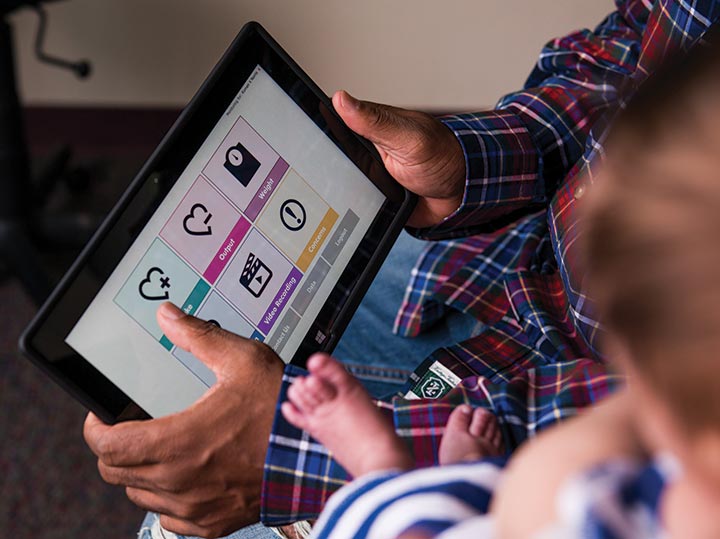The CHAMP app supports at-home monitoring of patients with single ventricle cardiac disease.
Takeaways:
- CHAMP is a single ventricle interstage application for home monitoring that transcends the organization by integrating the standardization of ambulatory care across the continuum and reduces events in this high-risk population.
- Communication and integrated support, including clinical and information technology staff, are a significant part of the continued success of this program.
- CHAMP is now used in numerous hospitals across the United States with technology and equipment support from the Claire Giannini Foundation and for implementation at a multi-site level from the 2016 ANCC Magnet Prize, sponsored by Cerner.
By Lori Erickson MSN, APRN, CPNP-PC; Cheri Hunt MHA, BSN, RN, NEA-BC; and Paula Blizzard MSN, RN, NE-BC
Discharge day from the hospital with a newborn is an exciting but often overwhelming experience for any new parent. A child with a life-threatening diagnosis only intensifies those anxieties. However, careful coordination, technology, enhanced communication, and ongoing caregiver support can ease fears and apprehensions for these families while improving the care and outcomes for the child.


Traditional care
Nearly 2,000 children are born each year with single ventricle (SV) cardiac diseases, such as hypoplastic left heart syndrome and heterotaxy with pulmonary atresia. Although the conditions can’t be fully corrected, patients with SV undergo a series of three surgeries in their first 5 years to reroute blood flow for survival.
After the initial surgery, which occurs in the first weeks of life, patients are admitted to an intensive care unit. They’re monitored closely by an interprofessional team until discharged home, where they don’t have immediate access to or the skills of an inpatient team. This causes incredible stress for parents and the post-acute care transition team as they wait for the child to progress to the next stage in the series.
During the first 6 months at home, known as the interstage period, children with SV are at high risk for sudden, unexplained death (2% to 20% mortality). Since 2003, interstage home monitoring programs have been used to allow providers, nutritionists, social workers, and nurses to work together to improve care, provide education, and support parents.
Traditionally, nurse coordinators evaluate and triage patients based on information collected in a three-ring binder by the caregivers and communicated weekly with the clinical team. This primarily reactive model leaves nurses waiting on calls from parents to address issues that occur at home. Although improvements in outcomes have occurred since implementing traditional home-monitoring programs nationwide, unpredicted and unexplained deaths still happen.
Technology steps in
In 2014, Children’s Mercy Kansas City, a pediatric academic medical center based in Missouri that celebrated its fourth Magnet®-recognition in 2016, implemented a cardiac high-acuity monitoring program (CHAMP) to improve communication and interstage patient monitoring. CHAMP uses a tablet-based, caregiver-driven monitoring application to support daily data transfer and video evaluation. The program was developed through the Children’s Mercy Ward Family Heart Center with funds from the Claire Giannini Foundation.
Data collected in the home through the CHAMP application is uploaded via a secure cloud-based system and available through a web portal and the electronic health record, where the team can access it. Nurse coordinators and advanced practice nurses review and integrate CHAMP data to minimize delays in care. This proactive design has led to a drastic decrease in at-home mortality from nearly 20% in 2012 to 1% over the past 3 years for Children’s Mercy patients with SV.
Additionally, this application transcends the organization by integrating the standardization of ambulatory care across the continuum for this population. As infants are readmitted to the hospital, their specialized risks and hemodynamic status are well-known by the cardiac care units, leading to early detection and intervention.
CHAMP creates a cost-effective, efficient workflow, with early evaluation and intervention of infants during the interstage period that includes a replicable algorithm for nursing care at other sites. A significant part of the continued success of this program is the communication and integrated support within the interprofessional team, including clinical and information technology staff.
CHAMP success
As of July 2017, CHAMP has been successfully deployed at four additional pediatric hospitals in the United States. Since May 2014, over 100 infants with SV at all five centers using CHAMP have an interstage mortality rate of less than 3%. Ten more pediatric hospitals are actively pursuing adoption of this program with others interested in the innovation.
In October 2016, Children’s Mercy won $50,000 through the American Nurses Credentialing Center’s ANCC Magnet Prize™, sponsored by Cerner, to further their work with this high-risk population.
Along with the CHAMP application and dissemination to other pediatric hospitals, the CHAMP team continues to investigate innovations beyond survival, focusing on helping patients with congenital heart disease thrive throughout their lives. Early progress has been made in developmental support and encouragement for attaining milestones for high-risk infants, implementing parent-to-parent support, developing mobile health technologies for managing cardiac conditions, and improving communication through technology.
| For more information about CHAMP, vist childrensmercy.org/champ. |
All three authors work at Children’s Mercy Kansas City in Missouri. Lori Erickson is the CHAMP clinical program manager, Cheri Hunt is senior vice president for patient care services and chief nursing officer, and Paula Blizzard is Magnet® program director.
Selected reference
Shirali G, Erickson L, Apperson J, et al. Harnessing teams and technology to improve outcomes in infants with single ventricle. Circ Cardiovasc Qual Outcomes. 2016;9(3):303-11.
Magnet Stories ANT September Journal


















